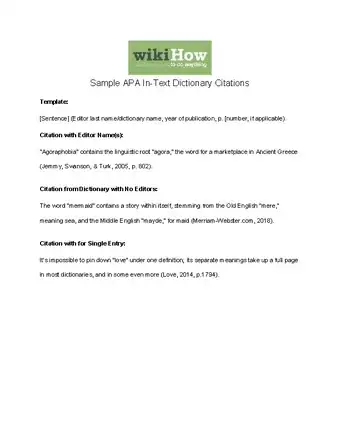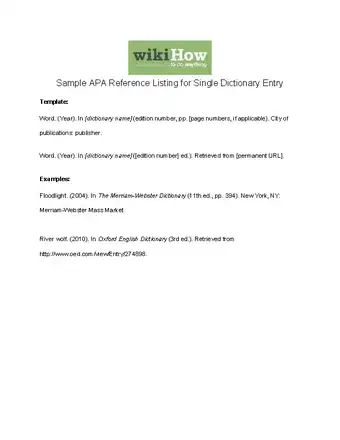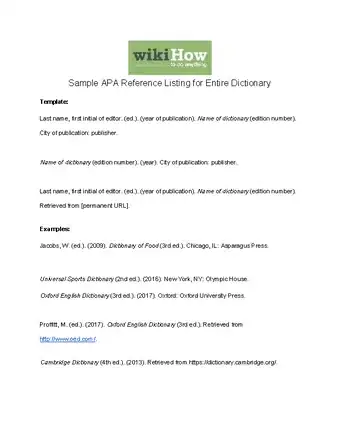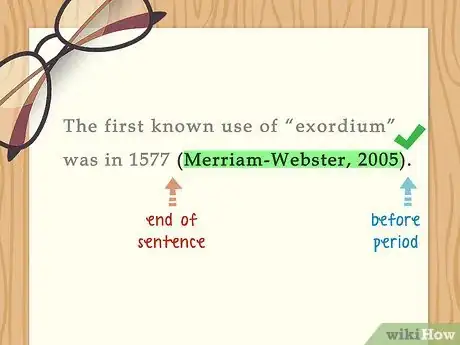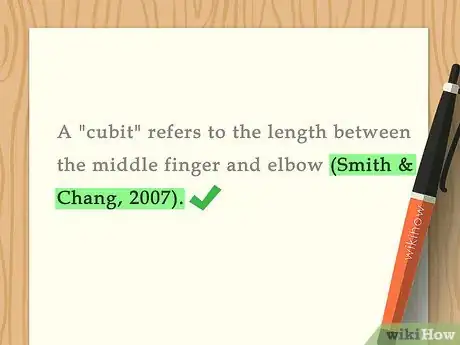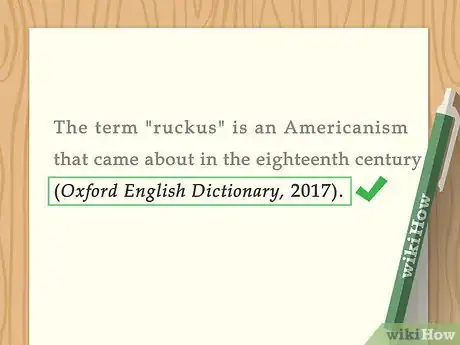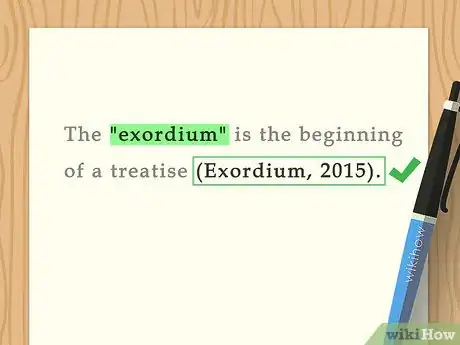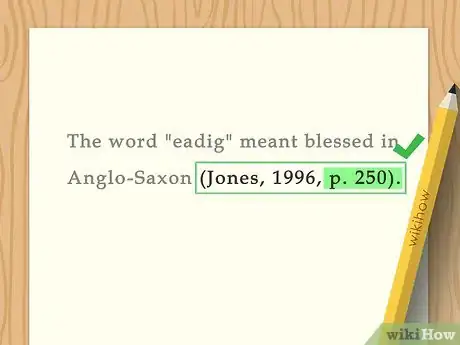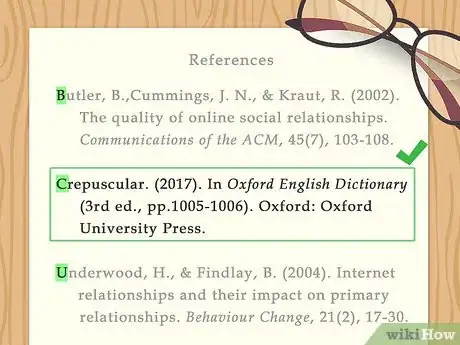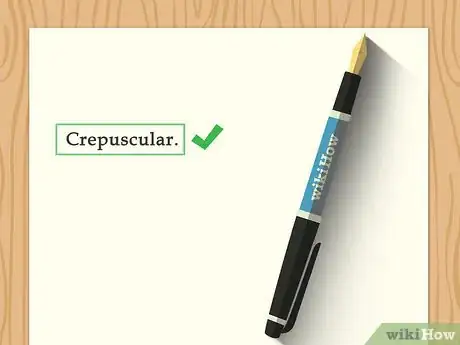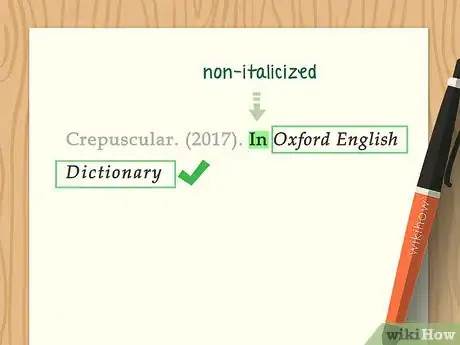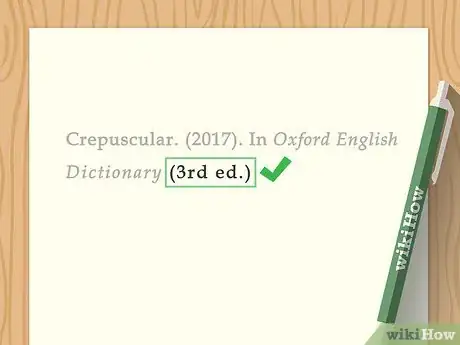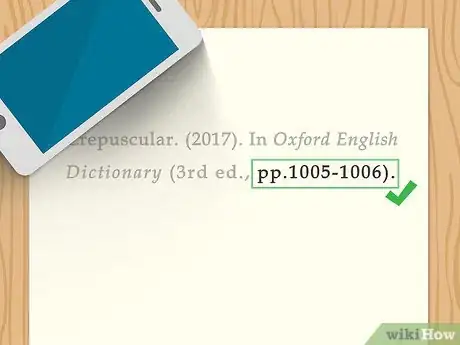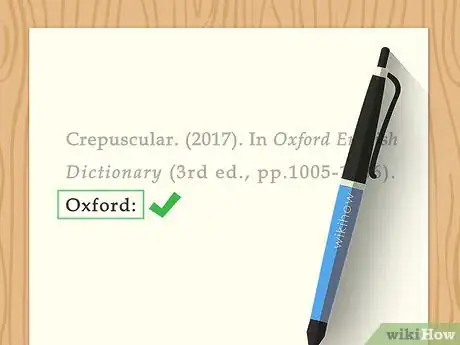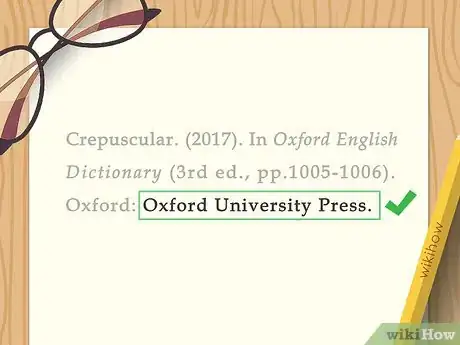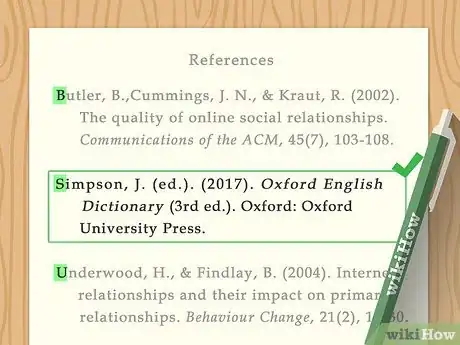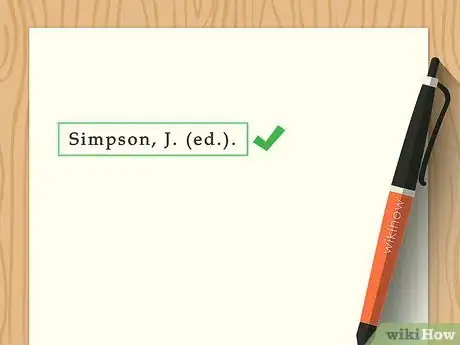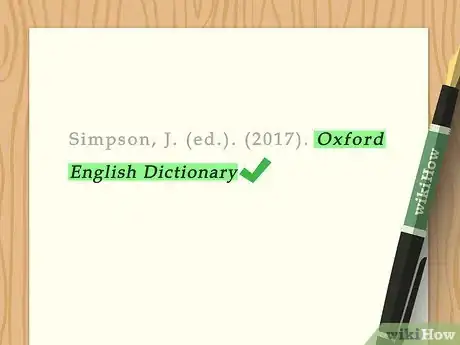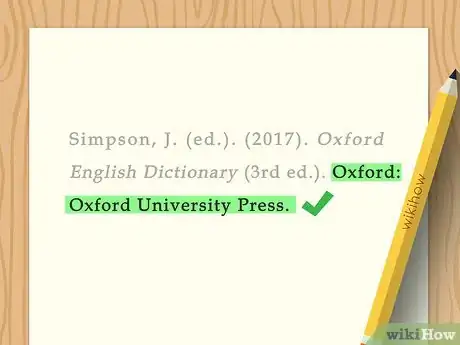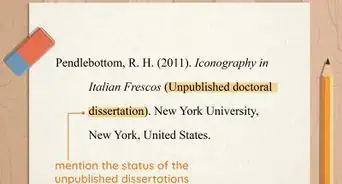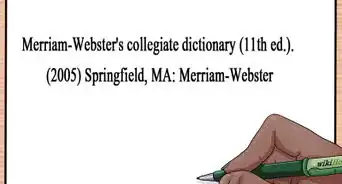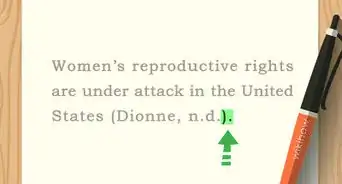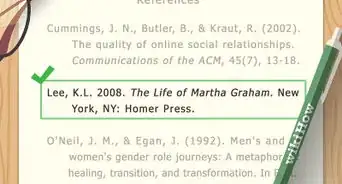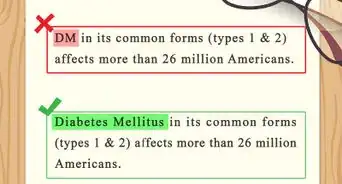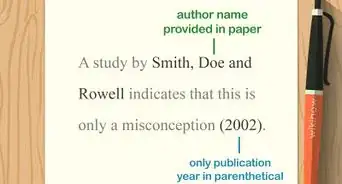This article was co-authored by Cara Barker, MA. Cara Barker is an Assistant Professor and Research and Instruction Librarian at Hunter Library at Western Carolina University. She received her Masters in Library and Information Sciences from the University of Washington in 2014. She has over 16 years of experience working with libraries across the United States.
There are 11 references cited in this article, which can be found at the bottom of the page.
This article has been viewed 56,931 times.
Dictionaries can be extremely useful when researching a paper or article, but the rules aren’t always clear when it comes to citing them in APA. Dictionaries are actually cited the same way as encyclopedias or other reference texts. You will need both in-text citations and a full reference in a reference list. How you cite the dictionary may depend on whether you are citing a single entry or word or if you are citing the entire text.
Steps
Sample Citations
Writing In-Text Citations
-
1Place the citation at the end of the sentence before the period. Put the citation in parentheses. Each citation will contain either the author’s name or title of the dictionary, the year of publication, and a page number if there is one. These are separated by commas. Your citation may look something like these:[1]
- Crepuscular is an adjective meaning “of or pertaining to twilight” (Simpson, 2017).
- The first known use of “exordium” was in 1577 (Merriam-Webster, 2005).
- Fabaceous appeared in Johnson’s first dictionary (Johnson, 1757, p. 757).
-
2Put the editor or author’s last name and the year in the parentheses. It is rare to find the editors or authors of a dictionary, but if you can find them, this is the preferred way of citing any text in APA. Separate the author's name and the year with a comma.[2]
- For example, if R.H. Smith edited the dictionary in 2007, your citation would look like this:
- A "cubit" refers to the length between the middle finger and elbow (Smith, 2007).
- If there are 2 authors or editors, write both last names with a “&” in between. For example:
- A "cubit" refers to the length between the middle finger and elbow (Smith & Chang, 2007).
- If there are 3 to 5 authors or editors, write out all of their last names, separated by commas. Place an “&” before the last one.
- A "cubit" refers to the length between the middle finger and elbow (Smith, Chang, Jones, Diaz, & Ahn, 2007).
- If there are 6 or more authors or editors, write out the first name and then write “et al.” after it. For example:
- A "cubit" refers to the length between the middle finger and elbow (Smith et al., 2007).
Advertisement - For example, if R.H. Smith edited the dictionary in 2007, your citation would look like this:
-
3Write the name of the dictionary to reference the entire work. This is especially useful if you do not have an editor or if you are using the dictionary to reference more than one word. Write the name in italics. You still need to include the year. Your citation might look like:[3]
- In Scots, "deasil" refers to a clockwise direction (Dictionary.com, 2017).
- The term "ruckus" is an Americanism that came about in the eighteenth century (Oxford English Dictionary, 2017).
-
4Put the word you are referencing if you are only citing one word. If you only used the dictionary for one word, use the word in the parentheses. This will help the reader find the citation in your reference list, which will begin with this word. For example:[4]
- The "exordium" is the beginning of a treatise (Exordium, 2015).
-
5Include a page number if you used a physical dictionary. Cite only the pages that you found the information on. If you used a digital dictionary, you do not need to use a page number. Write “p.” before the number for one page and “pp.” for multiple pages. For example, your citation might look like:[5]
- The word "eadig" meant blessed in Anglo-Saxon (Jones, 1996, p. 250).
- The term originally referred to an agreement between the Vatican and a foreign power (Concordat, 2001, pp. 191-192).
Referencing a Single Entry in the Reference List
-
1Include the citation alphabetically in your reference list. The reference is a full list of all of the citations you used in your paper. It goes at the very end of the paper. Arrange the list alphabetically by the last name of the author. If you do not have the last name of the author, use the title instead.[6]
-
2Write the word you referenced first. Capitalize the first letter of the word and place a period after the end of the word. For example, if you looked up the word "crepuscular," you would just write: Crepuscular.[7]
- If you used the dictionary to cite multiple words, do not use this method. Instead of citing individual entries, cite the entire dictionary instead.
-
3Place the year of publication in parentheses. Follow the parentheses with a period. You can find the year of publication by looking on the copyright page of a physical book. Online, check the "About" page or look at the bottom of the website. If you cannot find a date, put "n.d." instead. Your citation may now look like this:[8]
- Crepuscular. (2017).
-
4Put the full title of the dictionary in italics. Write the word “In” before the dictionary’s title but do not italicize it. Do not put any punctuation after the title of the dictionary. For example, your citation may now look like this:[9]
- Crepuscular. (2017). In Oxford English Dictionary
-
5Add the edition of the dictionary in parentheses. Put the number of the edition followed by “ed.” in the parentheses. Place a period after the parentheses. If you cannot find which edition it is, you may skip this part. Your citation may now look like:[10]
- Crepuscular. (2017). In Oxford English Dictionary (3rd ed.).
-
6Include the page numbers if you are citing a physical book. Include the full range of pages for the entry you are citing. Write "pp." before the pages. Include these in the parentheses with the edition number. If you do not have an edition number, place the page numbers in parentheses after the title of the dictionary.[11]
- A reference with both the edition and page numbers would look like this:
- Crepuscular. (2017). In Oxford English Dictionary (3rd ed., pp.1005-1006).
- A reference with just the page numbers would look like this:
- Crepuscular. (2017). In Oxford English Dictionary (pp.1005-1006).
- If you used a website, you do not need to include page numbers. Simply skip this part.
- A reference with both the edition and page numbers would look like this:
-
7Write the city of publication. If it was published in the US, include both the city and the state. After the location, put a colon. Your reference may now look like:[12]
- Crepuscular. (2017). In Oxford English Dictionary (3rd ed., pp.1005-1006). Oxford:
-
8Finish the reference with the name of the publisher. Put a period after the name of the publisher. You can find the publisher on the copyright page for a physical book. If it is an online dictionary, look at the bottom of the page or on the “About” page. A finished citation may look like:[13]
- Crepuscular. (2017). In Oxford English Dictionary (3rd ed., pp.1005-1006). Oxford: Oxford University Press.
-
9Replace the place of publication with a URL to cite an online dictionary. Write “Retrieved from” before the URL. Paste the entire URL to the end of the citation and put a period afterwards. Use a short URL (sometimes known as a permanent URL) instead of a long URL if possible. Your citation might look like:[14]
- Crepuscular. (2017). In Oxford English Dictionary (3rd ed.). Retrieved from http://www.oed.com/view/Entry/44259.
Citing a Whole Dictionary in the Reference List
-
1Place the citation in your reference list at the end of the paper. Make sure that you put all of your other citations from your paper in the list as well. Organize all of the sources, including the dictionary, alphabetically by the last name of the author. If you do not have the last name of the author, use the title of the work or dictionary instead.[15]
-
2Write the last name and first initials of the editors. The last name always goes first in an APA citation. Separate a list of names with commas and place an “&” before the last name. In parentheses after the name, write “ed.” to signify that this is the editor of the dictionary.[16]
- Remember to put a period after the parentheses. For example, if you were citing the Oxford English Dictionary, it would start with:
- Simpson, J. (ed.).
- If there is more than one editor use “eds.” instead of “ed.” For example, it might look like,
- Rice, L. & Hilbert, R. (eds.).
- If the dictionary does not include the names of its editors, leave this part blank. You will start the citation with the name of the dictionary instead.
- Remember to put a period after the parentheses. For example, if you were citing the Oxford English Dictionary, it would start with:
-
3Place the year of publication in parentheses. Place a period outside of the parentheses. For a book, this can be found on the copyright page. For a website, it is usually on the bottom of the webpage. The reference may now look like this:[17]
- Simpson, J. (ed.). (2017).
-
4Italicize the full name of the dictionary. Do not put any punctuation after the name of the dictionary. In the citation for the Oxford English Dictionary, it would now look like:[18]
- Simpson, J. (ed.). (2017). Oxford English Dictionary
-
5Put the edition number in parentheses. After the edition number write “ed.”, which stands for edition. After the parentheses, place a period. So in the citation for Oxford English Dictionary, you may have:[19]
- Simpson, J. (ed.). (2017). Oxford English Dictionary (3rd ed.).
-
6Write the city of publication and the publisher at the end. If it was published in the US, write the state as well. Separate the city and state with a comma. After the place of publication, put a colon. Write out the name of the publisher after the colon.[20]
- Simpson, J. (ed.). (2017). Oxford English Dictionary (3rd ed.). Oxford: Oxford University Press.
-
7Start with the name of the dictionary if you do not have an editor. In many cases, you may not be able to locate the editor of the dictionary. In this case, start with the name of the dictionary. Write the year in parentheses between the edition number and the place of publication. Your citation might look like:[21]
- Merriam-Webster's Collegiate Dictionary (11th ed.). (2005). Springfield, MA: Merriam-Webster, Inc.
-
8Put a URL instead of the place of publication to cite an online dictionary. Write “Retrieved from” before the URL. If possible, use a permanent link or a short URL instead of a very long one. Afterwards, finish the citation with a period. It may now look like:[22]
- Simpson, J. (ed.). (2017). Oxford English Dictionary (3rd ed.). Retrieved from http://www.oed.com.
Community Q&A
-
QuestionHow do you cite the definition of any word in-text citation APA style from the Merriam Webster dictionary?
 FayreCommunity AnswerFirst, you'd put the title and subtitle of the book, which in this case is Merriam-Webster's dictionary. Next, put the word "In" followed by the title. Now put the edition of the book (this can be found on the front cover or spine). Place the edition number in parentheses after the book title. After you've done that, put the place of publication and publisher (Merriam-Webster). If you just cite the book, the definition is therefore cited as well.
FayreCommunity AnswerFirst, you'd put the title and subtitle of the book, which in this case is Merriam-Webster's dictionary. Next, put the word "In" followed by the title. Now put the edition of the book (this can be found on the front cover or spine). Place the edition number in parentheses after the book title. After you've done that, put the place of publication and publisher (Merriam-Webster). If you just cite the book, the definition is therefore cited as well.
References
- ↑ https://academicanswers.waldenu.edu/faq/73139
- ↑ https://columbiacollege-ca.libguides.com/apa/encyclopediasanddictionaries
- ↑ http://www.apastyle.org/learn/faqs/cite-book-no-author.aspx
- ↑ http://libguides.css.edu/c.php?g=41681&p=265028
- ↑ https://columbiacollege-ca.libguides.com/apa/encyclopediasanddictionaries
- ↑ https://morningside.libguides.com/APA7/references
- ↑ http://libguides.css.edu/c.php?g=41681&p=265028
- ↑ https://morningside.libguides.com/APA7/references
- ↑ http://hbl.gcc.libguides.com/c.php?g=339562&p=2286668
- ↑ http://libguides.css.edu/c.php?g=41681&p=265028
- ↑ https://owl.purdue.edu/owl/research_and_citation/apa_style/apa_formatting_and_style_guide/reference_list_other_print_sources.html
- ↑ http://libguides.css.edu/c.php?g=41681&p=265028
- ↑ http://libguides.css.edu/c.php?g=41681&p=265028
- ↑ http://www.apastyle.org/learn/faqs/cite-book-no-author.aspx
- ↑ https://libguides.jcu.edu.au/apa/dictionaries
- ↑ https://columbiacollege-ca.libguides.com/apa/encyclopediasanddictionaries
- ↑ http://hbl.gcc.libguides.com/c.php?g=339562&p=2286668
- ↑ https://libguides.jcu.edu.au/apa/dictionaries
- ↑ http://www.apastyle.org/learn/faqs/cite-book-no-author.aspx
- ↑ http://www.apastyle.org/learn/faqs/cite-book-no-author.aspx
- ↑ http://www.apastyle.org/learn/faqs/cite-book-no-author.aspx
- ↑ http://www.apastyle.org/learn/faqs/cite-book-no-author.aspx
About This Article
To cite a dictionary in APA when you're writing an in-text citation, start the citation after the period of the sentence. Each citation will contain either the author’s name or title of the dictionary, the year of publication, and a page number if there is one. This information appears in parentheses and is separated by commas. For example, a correct in-text citation will look something like, "The first known use of “exordium” was in 1577 (Merriam-Webster, 2005)." For tips on referencing a single entry or the whole dictionary in the reference list, read on!
